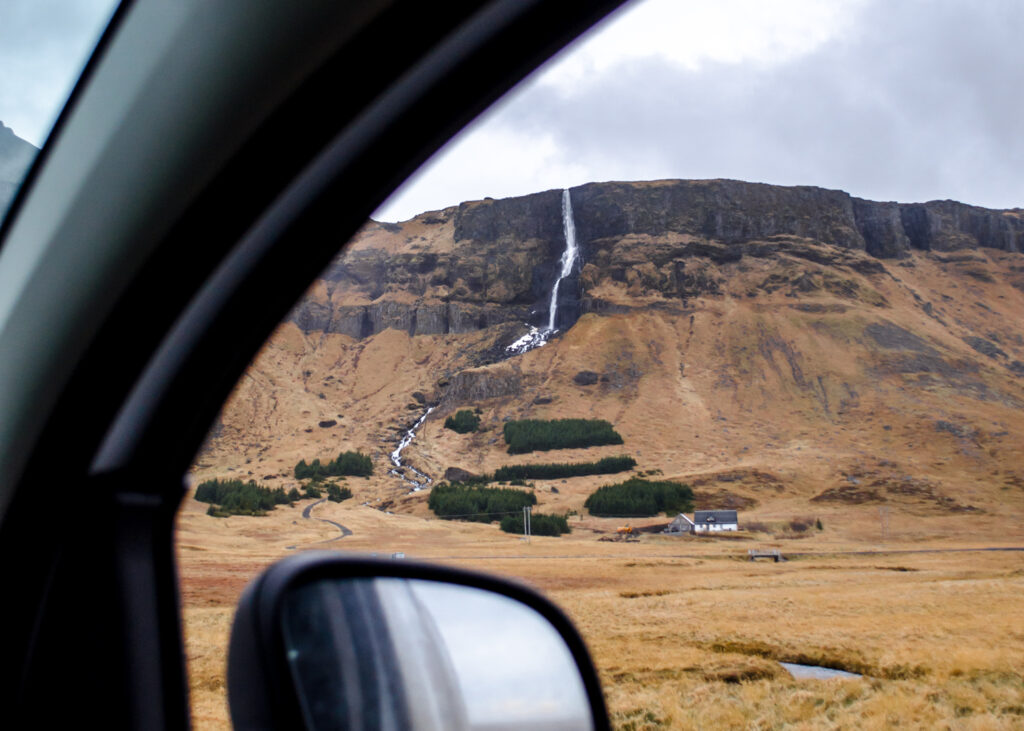Disclosure: This post contains affiliate links that I may earn a small commission from if you purchase something through them. This comes at no extra cost to you!
Doing an epic road trip around Iceland’s Ring Road really does live up to the hype, and for most it is the adventure of a lifetime.
It’s no secret that ‘The Land of Ice and Fire’ is one of the most surreal, beautiful and diverse countries on Earth, with natural landscapes and scientific phenomenons that will leave you standing there with your mouth wide open. In other words, it really is a road trip to get very excited about.
That said, it ain’t just like nipping to the shops or going on a Sunday drive. No, this environment is harsh and conditions can change in a matter of minutes, especially in winter. It can be an unforgiving and sometimes dangerous place if not appreciated properly.
As the old saying goes, “failing to prepare is preparing to fail”, so this guide focuses on some quick-fire need-to-know information to consider before starting your journey in Iceland, with the aim of saving you both money and hassle during your trip.
Table of Contents...
Toggle
Useful information for Iceland
- Capital: Reykjavik
- Language: Icelandic
- Population: 372,000
- Currency: Icelandic Krona (ISK): £1/$1 = 175/142 ISK
- Visa info: Iceland is a Schengen country, granting EU members free access between 27 European countries. Learn more here.
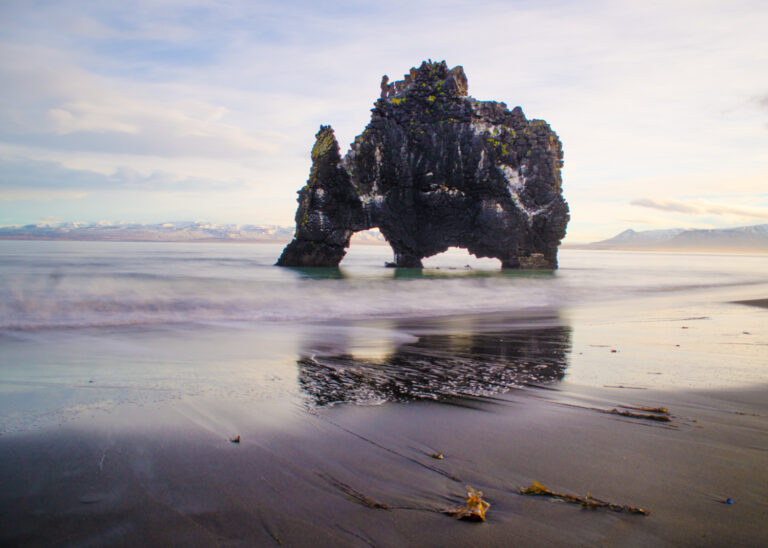
For a full Iceland road trip itinerary, including all essential information about visiting the country, read this: 10 Day Iceland Road Trip: Epic Budget Winter Ring Road Itinerary
19 Tips For Your Iceland Road Trip
1. When to visit? (travel in the off-season!)
Deciding when to visit Iceland largely depends on two things: would you like it A) sunny but busy, or B) quiet but snowy?
There’s no denying it… Iceland is like a circus in the high season (summer).
Despite only having just 5-6 hours of light in the height of winter, convoys of tour groups will either slow you down or affect your trip one way or another in summer, not to mention getting in the way of your pictures. In the winter (November to April) you can not only experience some proper Icelandic weather conditions, but also less photo-bombers and congestion on the roads.
Not only that, but you’ll save money too, because as with any popular destinations prices usually get hiked up for the busy months when there’s more of a demand.
The only downside I found about travelling in Iceland in the off season is that certain parts, such as the Westfjords and the central Highlands, are virtually inaccessible if you’re travelling by campervan. Most of the best attractions in Iceland are located around the Ring Road though, which remains open year round.
2. Repeat after me... "I will self-drive the Ring Road"
I cannot stress this enough: self-driving the Iceland Ring Road is SO rewarding and, to me, exploring on your own terms is a no-brainer.
Having the ability to stop and start whenever you want provides so much freedom, plus you can avoid big crowds if you time your days right. There are so many amazing stops along the way and you don’t want to miss a thing.
Furthermore, it’ll save you money! When I did my 10 day road trip around Iceland I rented a Renault Kangoo campervan £550. That may strike you as a lot, but if you compare it to the price of 10 nights in hotels or on a tour, then £55 per day is an absolute steal!
3. Car or campervan?
I touched on this above, but for a winter road trip in Iceland you have two vehicle rental options: a car or a campervan.
Both have their own pros and cons, but the more affordable and convenient option by far is to rent a campervan as you won’t need to worry about the sometimes extortionate hotel prices.
With a car there may be a couple of extra places you could add to your itinerary, but I’d highly recommend having a house on wheels. You don’t need a large van too, just something with the essentials like my wee Renault Kangoo below.
All you’ll need to buy are a few small gas bottles to put in the stove!
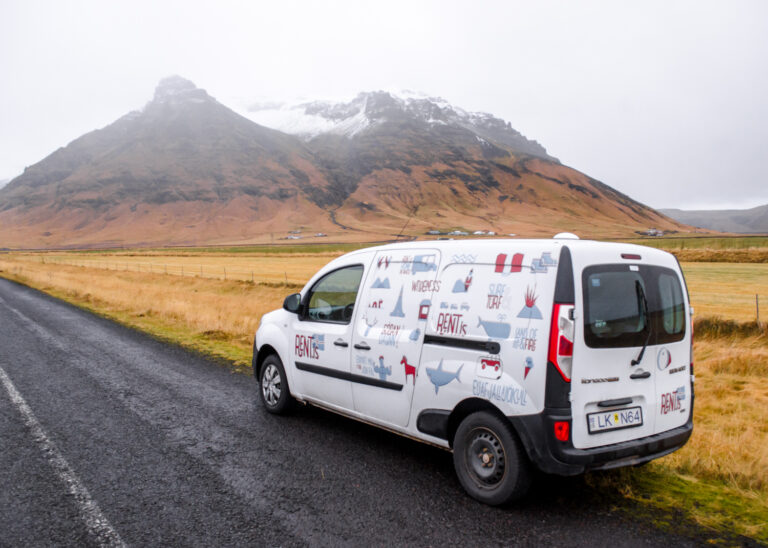
4. Allow at least 10 days in the country
There’s nothing worse than rushing through a road trip.
When you visit a country, no matter where it may be, you want to leave with a sense of accomplishment, not regret. Therefore it’s important to set aside a fair chunk of time for each location to be prepared for any spontaneous adventures or unforeseen issues
It largely depends on how much driving you are willing to do each day, but I think 7 or 8 days is perfect to see the best bits of Iceland while keeping a day or two extra to spend in Reykjavik on either side.
5. Check your van before departing
It’s vital to check over your vehicle before leaving the rental office, which is probably something the company will recommend anyway.
Not only should you look for existing damage and take photos, but also have a look at what condition certain parts are in.
For example:
- Does the bodywork have any existing scratches or dents?
- How’s the tread on your tyres? Are they winter tyres?
- Is there a spare wheel and what condition is it i
- Are there any cracks in the windscreen? Even small ones can became a big problem!
- Is there a SAT Nav if one was promised?
If you notice anything make sure you make the rental company aware to avoid a hefty bill later on.
On that note…
6. Get chip insurance
This is one of those things I would not normally recommend as it’s so unlikely you’ll ever need it, but you’re bound to wish you had it at some point in Iceland, like I did.
It’s a cheap addition to your vehicle rental and with so many loose stones on the roads here it’ll save you some pennies if you do get happen to get a windscreen chip.
On the last day of my trip a large stone flew up from a passing car and cracked the windscreen, leaving me to spend the rest of the day worrying about the size of the potentially hefty fine I’d receive for the damage.
Luckily though, the guy who searched over the van when I returned it didn’t notice… and I sure as heck was not going to pipe up!
I dodged a bullet, but I would recommend getting chip insurance when prompted, just in case.
7. Shop at Bonus supermarkets (and stock up!)
As Iceland has some of the highest living costs in the world, food shopping can be pretty damn pricey.
Bonus offers the best solution to a budget traveller’s needs as here you can find plenty of affordable travel foods like bread, noodles and pasta without breaking the bank too badly.
Because Bonus supermarkets are often spread miles apart, it’s best to stock up whenever possible. For example, once you pass the Bonus in Selfoss you’ll have to wait 645km until the next one in Egilsstadir!
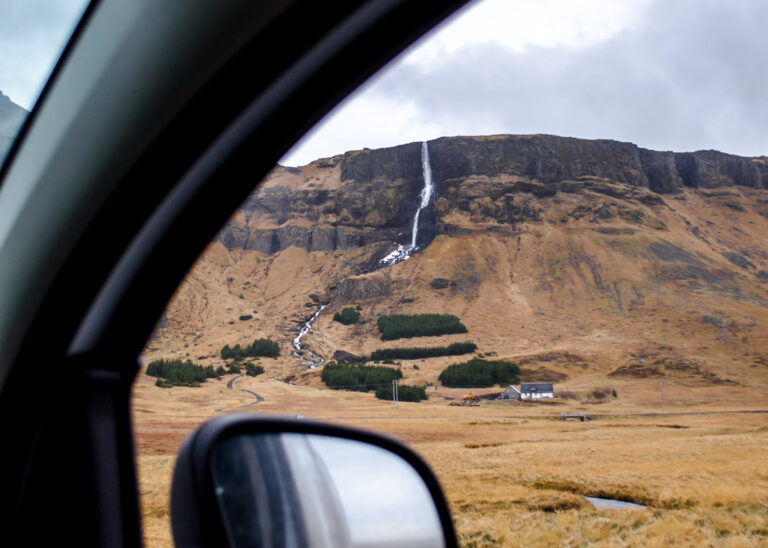
8. Where to camp
Possibly not the best thing to recommend, but hey, here we go.
I saved a bunch of cash when I travelled around Iceland in winter by finding remote, quiet places to park my campervan to sleep for the night.
A couple of good rules I used were to stay away from populated areas as much as possible and to arrive when it’s dark and leave before it gets light. That way you avoid any potential issues with locals, not that I had any.
Places like picnic areas or more remote lay-byes are perfect but make sure to scope out any “no camping” signs before settling in for the night.
Lots of campsites are closed during winter so you may have to resort to this once or twice whether you had planned to or not.
9. Constantly top up on fuel
Similar to what I said about stocking up at Bonus, there can often be hundreds of kilometres between petrol stations in Iceland.
Best top it up your fuel at every given opportunity just to be on the safe side.
10. Wake up for sunrise
Apart from allowing you to squeeze more sightseeing into the short Icelandic winter days, the sunrises here are just beautiful.
In winter the daylight only lasts for 5-7 hours, so it’s also a good idea to make the most of each day and avoid driving in the dark too often as well.
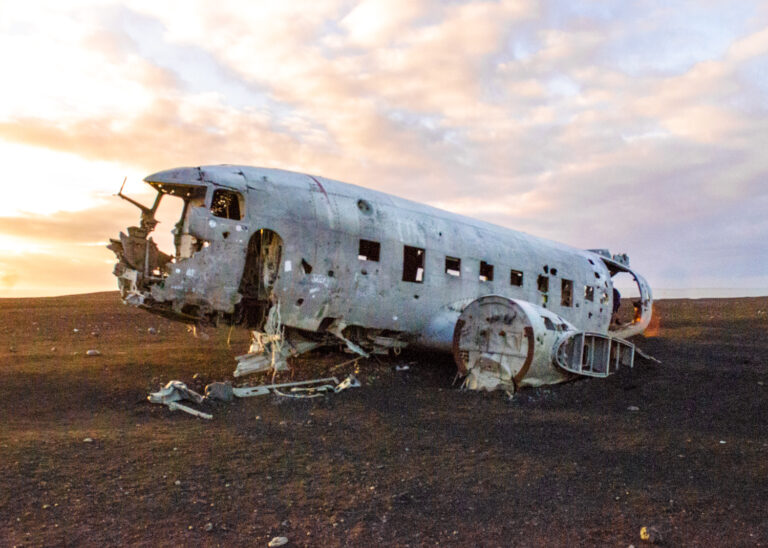
11. Download Maps.me for offline maps
The Ring Road is well signposted and fairly easy to follow as it is the only main road encompassing the country, but I strongly recommend having an offline map downloaded on your phone too.
Maps.me is the best app for this and allows you to pin locations, plan routes and use a GPS all while offline. Simply download your chosen country before you set off and then use it any time, unlike Google Maps.
Anyone can pin locations for others to see on Maps.me too, so you might find a hidden gem while travelling around that someone else added to the system.
12. Avoid the tourist traps
In order to stick to a budget while travelling in such an expensive destination, try to avoid overpriced sites and tours.
When I say tourist traps, what I really mean is avoid the Blue Lagoon and Northern Lights tours.
Did you know there are over 25 geothermal pools in Iceland? Yup, and some of them are even free! The Blue Lagoon is overpriced and crowded, so I recommend going elsewhere for a better experience – read this guide to learn about two of the others you can see.
Northern Lights tours are another thing I don’t recommend. You’re going on a road trip around Iceland in winter – you will see the Northern Lights… (probably). Download the Aurora Alerts and get alerts when the chances are high.
13. Check Aurora Alerts every night
In winter the Aurora Borealis could shine on any given night, especially if you’re not close to any towns or light pollution.
With this handy app you’ll get a notification if the Northern Lights are shining above wherever you are!
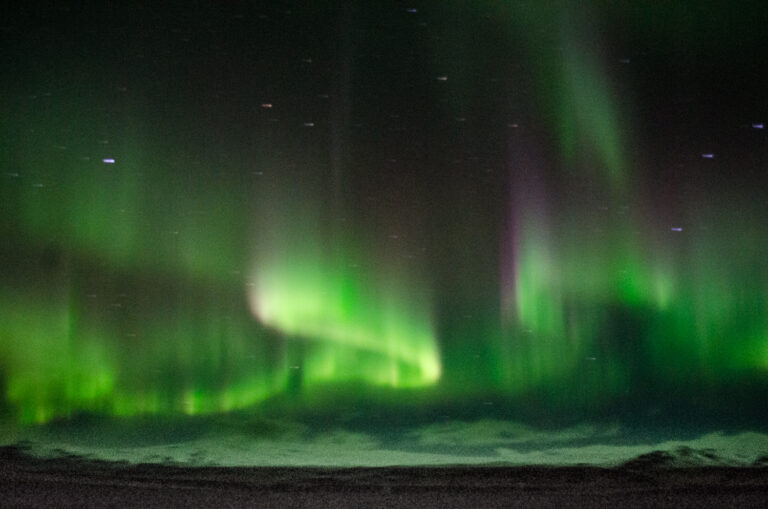
14. It should go without saying, but don’t drive like a tool!
It’s extremely important to know the rules of the road before you begin your trip, for example the fact that you drive on the right-hand side of the road in Iceland.
Always keep a safe distance from the car in front and don’t go too fast in weather conditions that you aren’t used to, especially when you never know what’s around the corner. Wild horses or reindeer could be anywhere!
15. Allow time in Reykjavik
Although a road trip around Iceland’s Ring Road is one of the best road trips in the world, don’t rush in and out of Reykjavik!
Give it a chance. There’s more than meets the eye in Iceland’s capital city and you should definitely allow a day or two (or even three!) before or after your road trip to get to know the place.
Take a free walking tour, try some affordable Icelandic cuisine and check out Hallgrimskirkja!
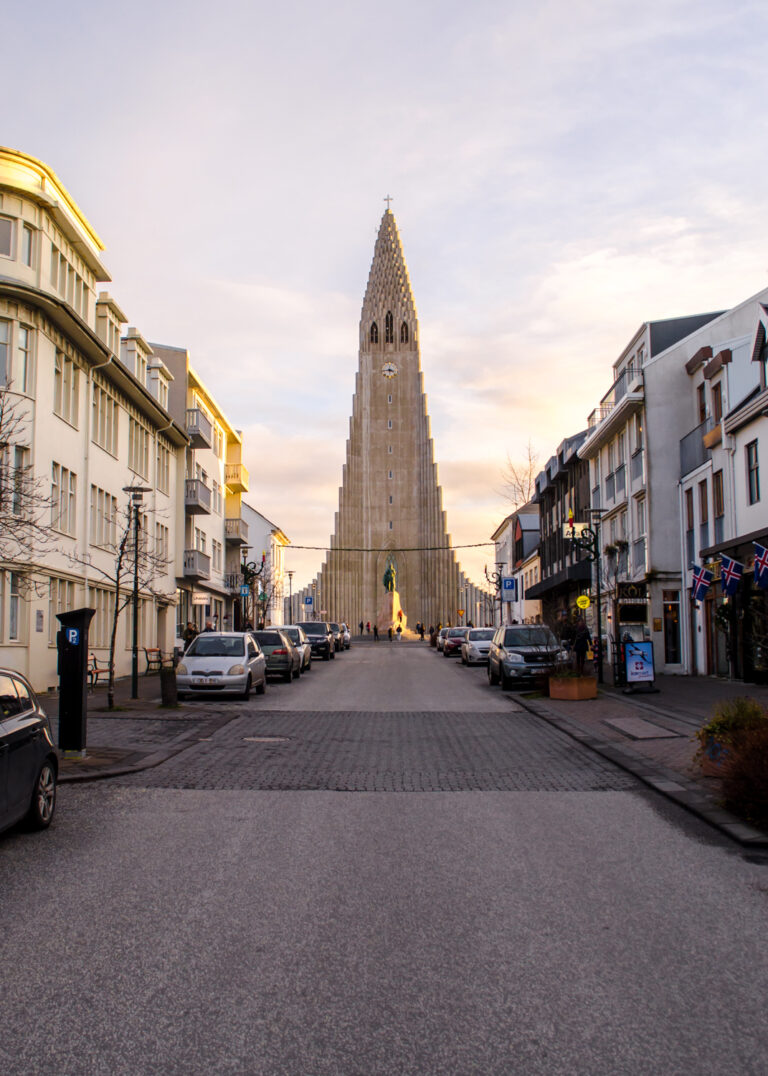
16. Emergency phone numbers
The emergency phone number in Iceland is 112, which you’ll hopefully never need to use. Just in case, it’s good to know.
There are many things that can unfortunately go wrong in a country where weather conditions are adverse, not to mention when towns are split up by hundreds of kilometres.
17. Be aware of where you can't (and shouldn't) go
This one is pretty straightforward – don’t try to take your campervan anywhere that a campervan shouldn’t go, and try to avoid private land.
For example, don’t try to ascend mountain tracks or get a cool shot of your van on a black sand beach. You will get stuck and look like an idiot, not to mention facing potential fines from your rental company or the police.
As friendly and welcoming as the locals are, it’s understandable that the small population of people who live in more rural areas will not appreciate you trespassing on their land. Be respectful. If you see something you want to stop at but it’s in somebody’s back garden (for reference, there are a lot of roadside waterfalls where this could apply), the best thing to do would be to politely knock on the door and ask if you can have a look.
18. Cook your own meals
If you want to save money in Iceland, don’t even think about going out for dinner or drinks!
Shopping at Bonus and making your own meals for your road trip is essential to keep the spending down. Plan ahead and prep some sandwiches for lunch or bulk-cook some pasta for dinner and have it for lunch the next day too.
19. Finally, enjoy it!
5 Iceland packing essentials
The harsh climate of a winter in Iceland call for certain essential items. Below are some things you’ll need before your adventure!
- Thick socks: It will be cold but you can do what you can to keep your toes warm! Buy some thick socks before you go!
- Head torch: With only a few hours of sunlight per day, you’ll likely need some light in the evenings. Check out this head torch.
- Waterproof jacket: Having a decent waterproof jacket or poncho is vital because you never know when the next snow storm is going to hit.
- Hiking boots: For wet, boggy and rocky walking trails it’s important to have sturdy hiking boots to protect your ankles. Make sure they’re waterproof!
- Travel towel: Having a compact travel towel is essential in Iceland, especially if you plan on going swimming in one of the thermal pools!
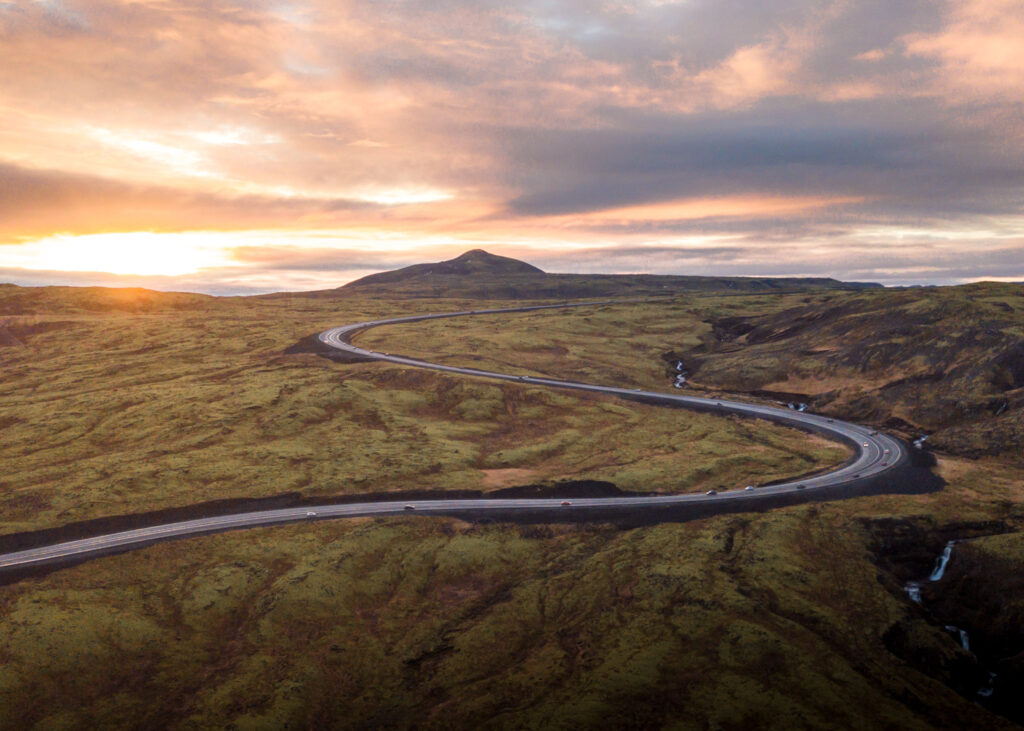
Best tours in Iceland
If you don’t feel confident enough to drive yourself, you’re not alone. Guided tours are popular and always available in Iceland. With this option you can travel stress-free and in comfort while still stopping at some of the country’s most iconic destinations with a local guide.

Thank you for reading this travel guide – I hope you found it helpful! Feel free to leave a comment below if you have any questions and I’ll get back to you as soon as possible
Happy travelling!
HELPFUL RESOURCES FOR PLANNING YOUR TRIP
Accommodation: Booking.com, Hostelworld
Tours: GetYourGuide, Viator, Klook, TripAdvisor
Transport: 12Go, Omio, Trip.com, Rome2Rio
WHO IN THE WORLD IS JAMES?
Click below to learn more about my story, including 5 random facts about me, some travel FAQ’s and my entire travel history.

